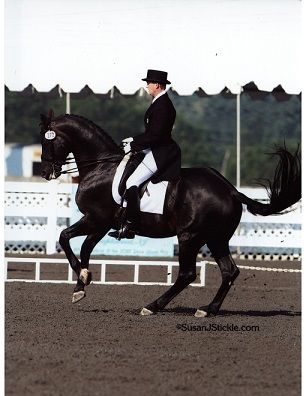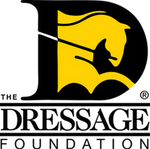Maryal Barnett: "Changing the Pirouette from “Marginal” to “Excellent”"

Photo: Photo by Susan J Stickle of Tom Noone on horse, Fred Astair, demonstrating lowering the haunches.
You may ask, “What can I do to increase the marks that I receive for my pirouettes from 5s to 8s, or better?” From the judge’s perspective, it is very interesting to observe the progression of the turns on haunches at Second Level to the pirouettes at the FEI Level. Each requires certain prerequisites before the horse is able to perform them well. Knowing what they are and then identifying what is missing in the horse’s education is the road map for increasing the marks received in the tests.
The turn on haunches is the first movement that we ask of our horses that eventually lead to the more demanding pirouettes at the canter. It comes out of the medium walk which is shortened just before the turn on haunches. If the horse has not been taught to shorten its stride with discreet aids coming mainly from the seat and leg, the horse is going to have difficulty making a quality turn. If the rider uses too much hand, chances are the rhythm of the walk will be compromised. If the horse is not supple enough in its connection, the correct bend is difficult which can create other problems such as stepping back, stepping wide or turning on the center. These are just a few of the reasons that low marks are given. It is important for the rider to address these basic skills at this point, as they will cause problems as the horse moves from the turn on haunches to the pirouette at the walk and finally to the pirouette at the canter.
The tests give the rider a progression to follow. The concept of pre-pirouette canter is introduced in Fourth Level, Test One. This is a skill that is essential for correctly balanced pirouettes. This adjustability and the development of the horse’s ability to lower its haunches are the path to “Good,” “Very Good,” and “Excellent” pirouettes in the FEI Levels. There are many different adjustability exercises that can be used to develop the horse’s strength. Also at Fourth Level, working pirouettes are introduced. The concept of having the horse between the rider’s two legs so that the rider has the ability to control the turn and therefore the balance is emphasized in these working pirouettes in tests 2 and 3. Again, it is up to the imagination of the trainer/rider to develop the exercises that are most beneficial to the horse at this time of its training.
The half-pirouette at Prix St. George must have the above skills for the horse to perform it well and confidently. It is necessary that the basics of the Pyramid of Training are confirmed. Additionally, the mark can be enhanced by the quality of the canter and modifiers such as using the corner to set up the movement and riding a straight line both before and after. Often, it is the little things that can make a difference between one mark and another. Let the high marks of 8s, 9s and 10s be your goal!
About the author: Maryal serves as Chairman of the Board of The Dressage Foundation. She is a USEF "S" Dressage Judge, retired FEI Judge and a member of the USDF "L" Education Program Faculty and a retired USDF Instructor/Trainer Faculty and Examiner.
